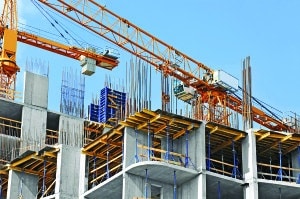Boston Mayor Marty Walsh doesn’t strut around acting like the city’s development czar. He doesn’t design tower tops, as his legendary predecessor did, to the detriment of the city’s skyline, with the resulting “baby bottle” high-rise at 111 Huntington.
Nor does he have a reputation as a micromanager with his eye on development projects large and small, one who makes every builder in town know who is boss, as the late, great Mayor Thomas M. Menino was apt to do.
Rather, Walsh lets the Boston Planning and Development Agency do its job, weighing in as occasion demands it on the big things.
And Walsh’s more hands-off approach appears to be paying dividends in the form of a record-shattering surge of new construction, from luxury towers and affordable apartments to corporate skyscrapers.
Since Walsh took office four and a half years ago, City Hall has issued more permits for new housing than the previous eight years under Menino. And nearly as much housing has actually gotten built under Walsh than during the final two terms of Boston’s longest-serving mayor.
The same is true for new commercial development, from office towers to hotels, with as much or more being built or approved in the last few years than in the previous eight.
Obviously, the economy in Massachusetts and across the country has gone into overdrive since 2014, so Walsh is clearly benefiting from that.
During his last term, Menino had to grapple with the fallout from the Great Recession, which brought new construction to a halt and left a massive hole in the heart of Downtown Cross when the Filene’s redevelopment plan came to a sudden halt.
Even so, the development numbers posted during the previous four years at the height of the last real estate boom pale in comparison to what we are seeing how.

Scott Van Voorhis
Rebranding the BRA
There are a couple things Walsh is doing right, and that’s paying off with more badly needed homes, condos, apartments and yes, corporate offices.
First, Walsh has put the Boston Planning and Development Agency back in charge of deciding what gets built in the city and what doesn’t.
Brian Golden, the agency’s chief executive, holds twice weekly senior staff meetings, where projects are discussed and problems and approaches hammered out. That’s in sharp contrast to the previous administration, with Golden recalling just two senior staff meetings at the development agency in the four years before Walsh became mayor.
It wasn’t that staffers at the old Boston Redevelopment Authority (since renamed the BPDA under Walsh) were a bunch of slackers. Rather, the real power in Boston development back then ran through the mayor’s office on the fifth floor of City Hall.
Menino and a trusted advisor or two called the shots, with hapless BRA directors like Mark Maloney trotted out to put a happy face – and too often to shamelessly deny the obvious – after the mayor made his decisions behind closed doors.
The rechristened BPDA now employs 42 planners, up from 27 before Walsh became mayor, part of a larger reinvigoration of the agency’s planning arm.
However, there’s another big reason for the development boom Boston is seeing under Walsh. Walsh, and his administration as a whole, handles conflict a lot than Menino did. As a result, developers are freer to do their jobs – and speak their minds – without fear of permanently alienating the mayor and sparking a years-long grudge.
For all I know, Walsh seethes with resentment every time Don Chiofaro, a tower developer with all the charm of a bull in the china shop, opens his mouth. Menino certainly did, boxing out Chiofaro, as well as developer John Hynes III (son the legendary newscaster and grandson of a mayor) and, to some extent, Tom O’Brien, who did a short stint as the city’s development chief under the late mayor.
An ill-considered, off-hand remark or seemingly innocuous joke could easily land a developer in hot water with Menino, who would respond by freezing out developers who displeased him. That meant never-ending development reviews or simply inaction on part of City Hall on vital permit requests.
But if Walsh is obsessed with settling scores, so far it’s not readily apparent. Chiofaro has City Hall’s blessing to build a new harborside tower, Hynes is a key player in building out the Seaport and O’Brien is overseeing the city’s next development frontier, Suffolk Downs, this time as a private developer.
Comparing Numbers
It’s the numbers that really tell the tale: Under Walsh, Boston has awarded 19,276 permits for new homes, condos and apartments, according to the Department of Neighborhood Development.
During the last eight years of Menino’s reign, that number totaled 16,680, the agency notes.
Narrowing that down to completed units, 15,586 have been built so far since the start of 2014, compared to 16,988 from 2004 through 2013.
Ditto for commercial projects. Over the past four and a half years, City Hall has given the green light to 199 new office towers, hotels, retail projects, lab complexes, among other uses. That’s just about the same number approved (201) from 2005 through 2013, according to the BPDA.
Of the 24 million square feet in new office space given the OK by City Hall since 2005, roughly 15 million of it has been approved since 2014.
Walsh is hardly perfect and he has certainly had his challenges, including allegations of a too-cozy relationship between members of his administration and local union chiefs. But when it
comes to spurring new development, Boston’s mayor seems to have found a winning formula. And it’s not just about what he’s doing, but what he’s not doing, which is trying to be the city’s master builder.
Cheers to that!
Scott Van Voorhis is Banker & Tradesman’s columnist; opinions expressed are his own. He may be reached at sbvanvoorhis@hotmail.com.




 |
| 


